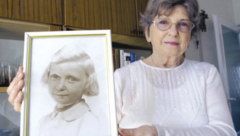Personal (Hi)Stories
Personal (hi)stories of individuals (either with an uprooted past or responsibility for these events)
-
1935–1975
Halina Czeszak
Halina Czeszak was born in Poznań in 1935. In 1940 or 1941 she was stolen from her family and underwent a process of Germanization at a special Lebensborn centre.
-
Folker Heinecke / Aleksander Litau
In 1942, Hitler’s troops invaded Soviet Crimea (now in Ukraine) and changed this toddler’s fate forever.
-
Anni-Frid “Frida” Lyngstad
During World War II, the Lebensborn programme encouraged German soldiers to have relationships with Scandinavian women because they were blonde and blue-eyed, which made them perfect for creating offspring for the Aryan master race. However, after the war, these women were deprived of their civil rights, detained or expelled from the country; they were called the “German whores” and their children received derogatory nicknames.
-
1932–2021
Marie Šupikova
Marie Šupikova, born Doležalová, was one of the nine Lidice children who survived racial selection and forced “Germanization” (everyone else in the village of Lidice was killed or transported to concentration camps). Her father was shot in Lidice and her mother was deported to the Ravensbrück concentration camp.
-
Zyta Suś
Zyta was born in Łódź, Poland, in 1934. After the death of her mother, she was placed in an orphanage. Because of her “Aryan” appearance, she was abducted from there and sent to a “re-education centre” and, after that, to the “Reich School for Volksdeutsche” in Achern. There, Sus was strictly forbidden to speak her native Polish. Once, Zyta tore down a poster of Hitler from a wall in the school. As a punishment, she was locked in the basement and starved. Later on, she was adopted by a loving foster family in Salzburg, Austria.
-
“The Woman Who Gave Birth For Hitler”
Hildegard Trutz
Hildegard Trutz, a devoted member of the League of German Girls (female Hitler Youth) since 1933, had been a loyal supporter of the Nazis. Because of her blond hair and blue eyes and her “long legs and long trunk, broad hips and pelvis built for child-bearing”, she was a perfect example of “Aryan woman”. So, at 18, she was introduced to the state-sponsored programme known as Lebensborn. In order to raise the birth rate of “Aryan” children, racially “pure” women were chosen to sleep with SS officers and, hopefully, bear a child.
-
Erika Matko
“In the summer of 1942, parents across Nazi-occupied Yugoslavia were required to submit their children to medical checks designed to assess racial purity. One such child, Erika Matko, was nine months old when Nazi doctors declared her fit to be a “Child of Hitler”. Taken to Germany and placed with politically vetted foster parents, Erika was renamed Ingrid von Oelhafen. Many years later, Ingrid began to uncover the truth of her identity.” (Ingrid von Oelhafen, Hitler’s Forgotten Children: A True Story of the Lebensborn Program and One Woman’s Search for Her Real Identity, Dutton Caliber (publishing), 2016)
-
1936–2015
Zorka Delić-Skiba
During World War II, a large part of today’s Croatia and Bosnia and Herzegovina, as well some parts of Slovenia and Serbia, were occupied by the Nazi puppet state NDH (Independent State of Croatia). It was governed by the fascist Ustasha movement. The NDH regime targeted Serbs, Roma, Jews and political dissidents. Many of them died in one of the 22 concentration camps (two of them, Jastrebarsko and Sisak, were only for children).
-
Hans-Ulrich Wesch
He was born in a Lebensborn home in Wernigerode, a small town in the former East Germany, in 1943 and separated from his unwed mother shortly after that. His birth mother wanted to marry his birth father and take him back from foster care, but his father died before the war and the authorities wouldn’t allow her to do so.
-
Dorothee Schmitz-Köster’s Collection
Starting in the mid-1990s, for more than 25 years, an author and journalist, Dorothee Schmitz-Köster, researched the topic of Lebensborn and created an extensive and very valuable personal archive. She started with her own “Friesland” neighbourhood near Bremen, but later expanded the search as far as Poland. The documents, interviews, stories from contemporary witnesses, and notes in her collection, many of them published, include interviews with Lebensborn mothers, children and employees in a wide range of audio formats. There are also some private records and photos of Lebensborn children that were given to her by different private individuals. All the materials she collected resulted in the publication of four books and numerous radio and television programmes.
-
Alodia Witaszek/ Alice Wittke/Dahl
The example of the Witaszek family shows how the Nazis also obtained “racially valuable” children from their enemies.
-
7 October 1900 – 23 May 1945
Heinrich Himmler
One of the most important people in Nazi Germany, the man in charge of the extermination and concentration camps, joined the Nazi party in 1925. His anti-Semitic attitudes and extreme loyalty helped him to become an SS leader by 1929.











